check engine NISSAN FRONTIER 2015 D23 / 3.G Towing Guide
[x] Cancel search | Manufacturer: NISSAN, Model Year: 2015, Model line: FRONTIER, Model: NISSAN FRONTIER 2015 D23 / 3.GPages: 27, PDF Size: 0.48 MB
Page 3 of 27
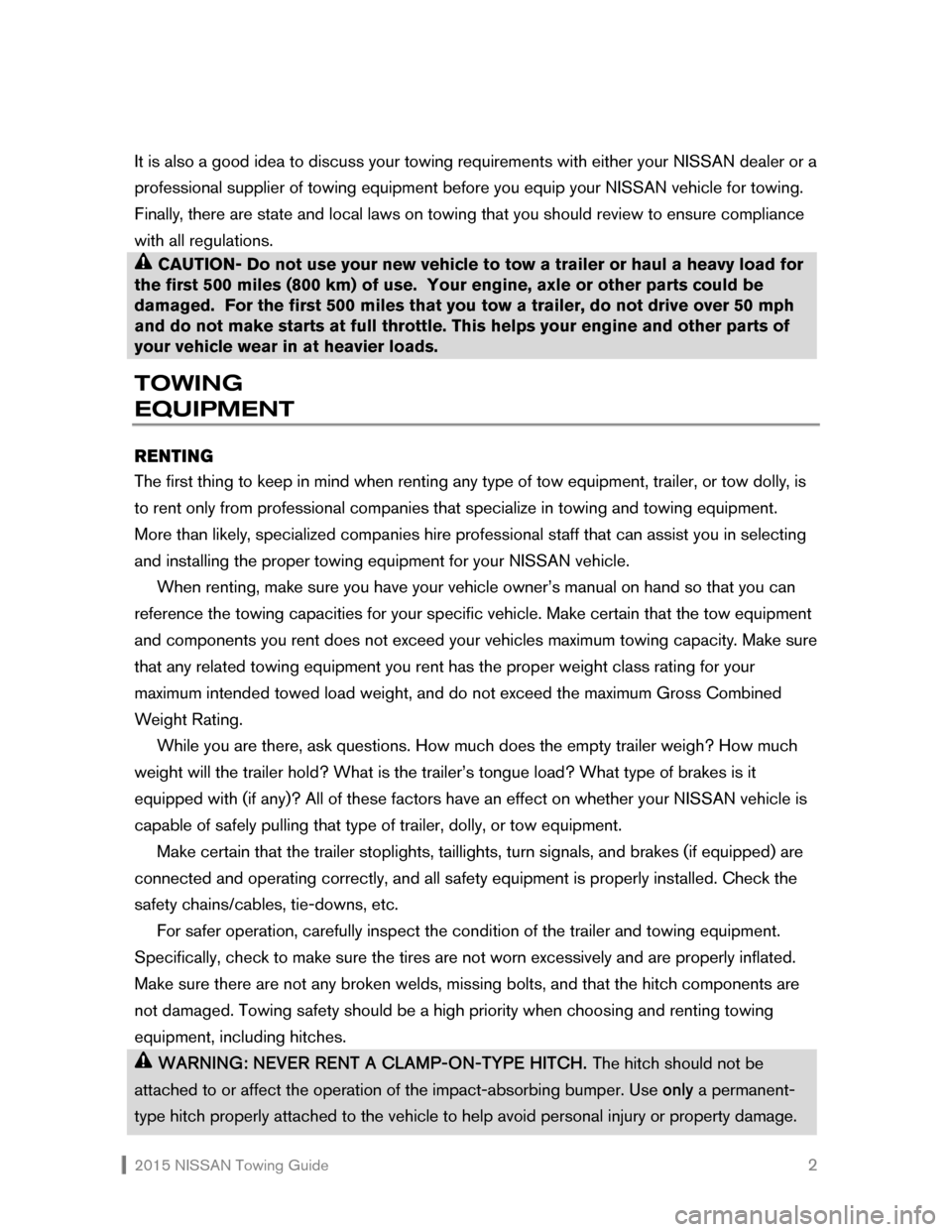
2015 NISSAN Towing Guide 2
It is also a good idea to discuss your towing requirements with either your NISSAN dealer or a
professional supplier of towing equipment before you equip your NISSAN vehicle for towing.
Finally, there are state and local laws on towing that you should review to ensure compliance
with all regulations.
CAUTION- Do not use your new vehicle to tow a trailer or haul a heavy load for
the first 500 miles (800 km) of use. Your engine, axle or other parts could be
damaged. For the first 500 miles that you tow a trailer, do not drive over 50 mph
and do not make starts at full throttle. This helps your engine and other parts of
your vehicle wear in at heavier loads.
TOWING
EQUIPMENT
RENTING
The first thing to keep in mind when renting any type of tow equipment, trailer, or tow dolly, is
to rent only from professional companies that specialize in towing and towing equipment.
More than likely, specialized companies hire professional staff that can assist you in selecting
and installing the proper towing equipment for your NISSAN vehicle.
When renting, make sure you have your vehicle owner’s manual on hand so that you can
reference the towing capacities for your specific vehicle. Make certain that the tow equipment
and components you rent does not exceed your vehicles maximum towing capacity. Make sure
that any related towing equipment you rent has the proper weight class rating for your
maximum intended towed load weight, and do not exceed the maximum Gross Combined
Weight Rating.
While you are there, ask questions. How much does the empty trailer weigh? How much
weight will the trailer hold? What is the trailer’s tongue load? What type of brakes is it
equipped with (if any)? All of these factors have an effect on whether your NISSAN vehicle is
capable of safely pulling that type of trailer, dolly, or tow equipment.
Make certain that the trailer stoplights, taillights, turn signals, and brakes (if equipped) are
connected and operating correctly, and all safety equipment is properly installed. Check the
safety chains/cables, tie-downs, etc.
For safer operation, carefully inspect the condition of the trailer and towing equipment.
Specifically, check to make sure the tires are not worn excessively and are properly inflated.
Make sure there are not any broken welds, missing bolts, and that the hitch components are
not damaged. Towing safety should be a high priority when choosing and renting towing
equipment, including hitches.
WARNING: NEVER RENT A CLAMP-ON-TYPE HITCH. The hitch should not be
attached to or affect the operation of the impact-absorbing bumper. Use only a permanent-
type hitch properly attached to the vehicle to help avoid personal injury or property damage.
Page 16 of 27
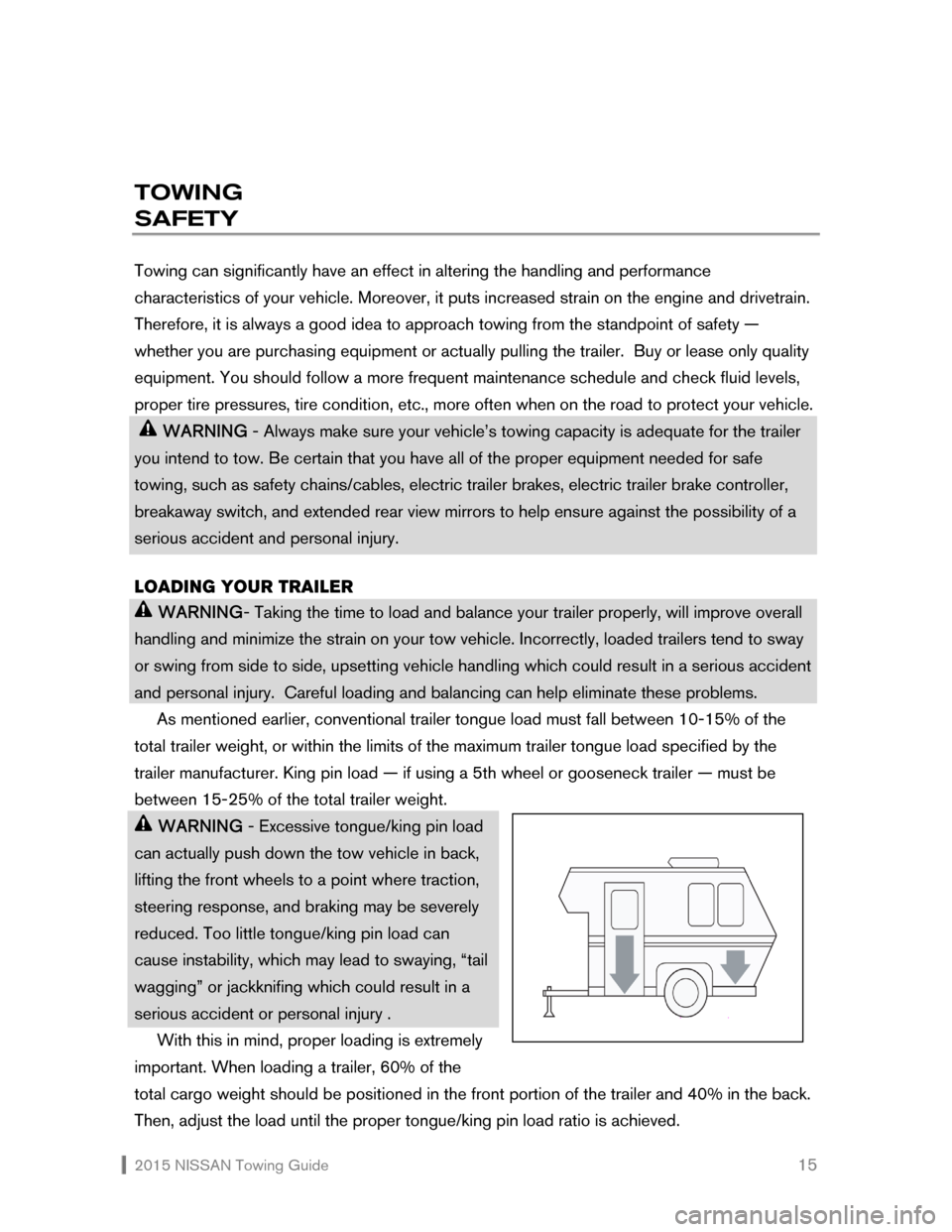
2015 NISSAN Towing Guide 15
TOWING
SAFETY
Towing can significantly have an effect in altering the handling and performance
characteristics of your vehicle. Moreover, it puts increased strain on the engine and drivetrain.
Therefore, it is always a good idea to approach towing from the standpoint of safety —
whether you are purchasing equipment or actually pulling the trailer. Buy or lease only quality
equipment. You should follow a more frequent maintenance schedule and check fluid levels,
proper tire pressures, tire condition, etc., more often when on the road to protect your vehicle.
WARNING - Always make sure your vehicle’s towing capacity is adequate for the trailer
you intend to tow. Be certain that you have all of the proper equipment needed for safe
towing, such as safety chains/cables, electric trailer brakes, electric trailer brake controller,
breakaway switch, and extended rear view mirrors to help ensure against the possibility of a
serious accident and personal injury.
LOADING YOUR TRAILER
WARNING- Taking the time to load and balance your trailer properly, will improve overall
handling and minimize the strain on your tow vehicle. Incorrectly, loaded trailers tend to sway
or swing from side to side, upsetting vehicle handling which could result in a serious accident
and personal injury. Careful loading and balancing can help eliminate these problems.
As mentioned earlier, conventional trailer tongue load must fall between 10-15% of the
total trailer weight, or within the limits of the maximum trailer tongue load specified by the
trailer manufacturer. King pin load — if using a 5th wheel or gooseneck trailer — must be
between 15-25% of the total trailer weight.
WARNING - Excessive tongue/king pin load
can actually push down the tow vehicle in back,
lifting the front wheels to a point where traction,
steering response, and braking may be severely
reduced. Too little tongue/king pin load can
cause instability, which may lead to swaying, “tail
wagging” or jackknifing which could result in a
serious accident or personal injury .
With this in mind, proper loading is extremely
important. When loading a trailer, 60% of the
total cargo weight should be positioned in the front portion of the trailer and 40% in the back.
Then, adjust the load until the proper tongue/king pin load ratio is achieved.
Page 17 of 27
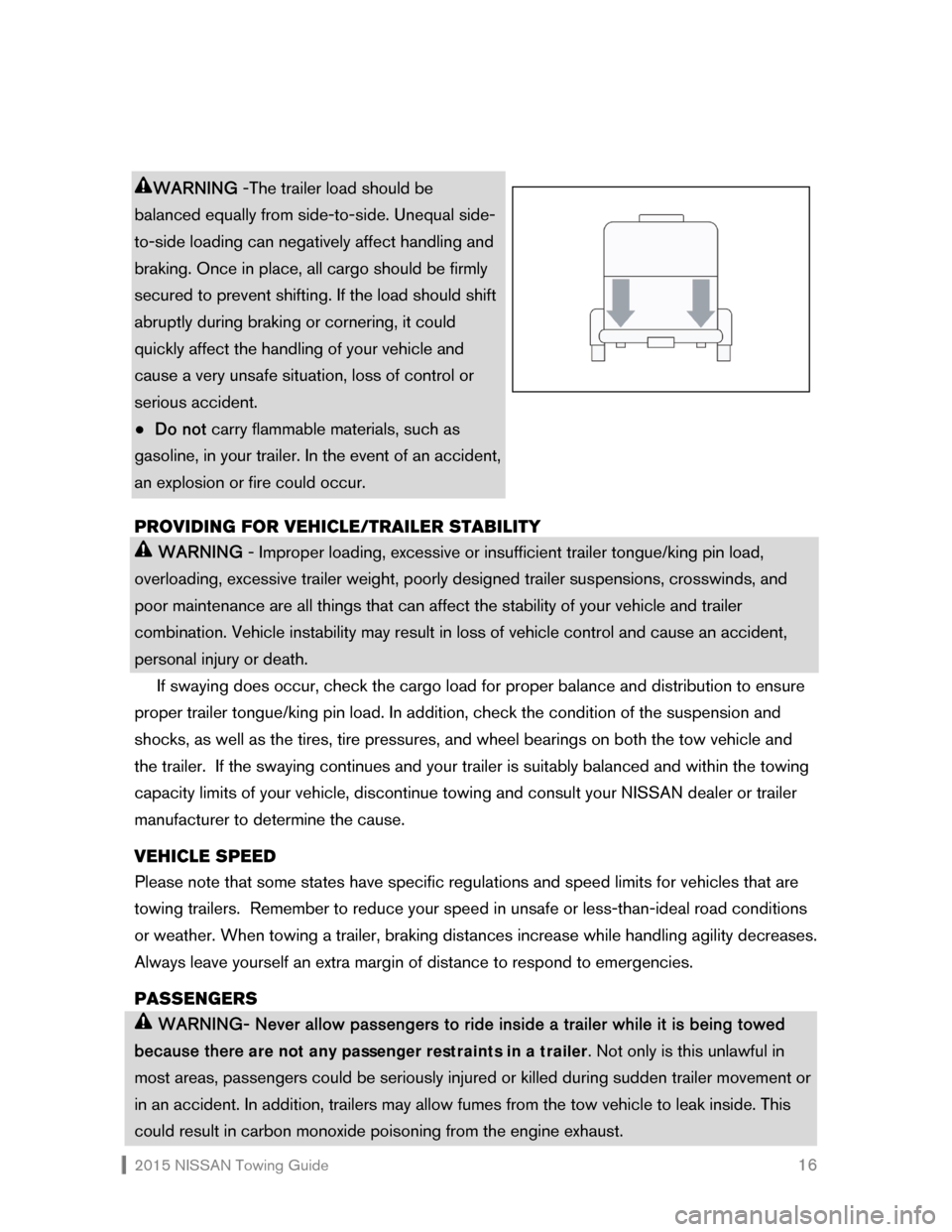
2015 NISSAN Towing Guide 16
WARNING -The trailer load should be
balanced equally from side-to-side. Unequal side-
to-side loading can negatively affect handling and
braking. Once in place, all cargo should be firmly
secured to prevent shifting. If the load should shift
abruptly during braking or cornering, it could
quickly affect the handling of your vehicle and
cause a very unsafe situation, loss of control or
serious accident.
● Do not carry flammable materials, such as
gasoline, in your trailer. In the event of an accident,
an explosion or fire could occur.
PROVIDING FOR VEHICLE/TRAILER STABILITY
WARNING - Improper loading, excessive or insufficient trailer tongue/king pin load,
overloading, excessive trailer weight, poorly designed trailer suspensions, crosswinds, and
poor maintenance are all things that can affect the stability of your vehicle and trailer
combination. Vehicle instability may result in loss of vehicle control and cause an accident,
personal injury or death.
If swaying does occur, check the cargo load for proper balance and distribution to ensure
proper trailer tongue/king pin load. In addition, check the condition of the suspension and
shocks, as well as the tires, tire pressures, and wheel bearings on both the tow vehicle and
the trailer. If the swaying continues and your trailer is suitably balanced and within the towing
capacity limits of your vehicle, discontinue towing and consult your NISSAN dealer or trailer
manufacturer to determine the cause.
VEHICLE SPEED
Please note that some states have specific regulations and speed limits for vehicles that are
towing trailers. Remember to reduce your speed in unsafe or less-than-ideal road conditions
or weather. When towing a trailer, braking distances increase while handling agility decreases.
Always leave yourself an extra margin of distance to respond to emergencies.
PASSENGERS
WARNING- Never allow passengers to ride inside a trailer while it is being towed
because there
are not any passenger restraints in a trailer. Not only is this unlawful in
most areas, passengers could be seriously injured or killed during sudden trailer movement or
in an accident. In addition, trailers may allow fumes from the tow vehicle to leak inside. This
could result in carbon monoxide poisoning from the engine exhaust.
Page 18 of 27
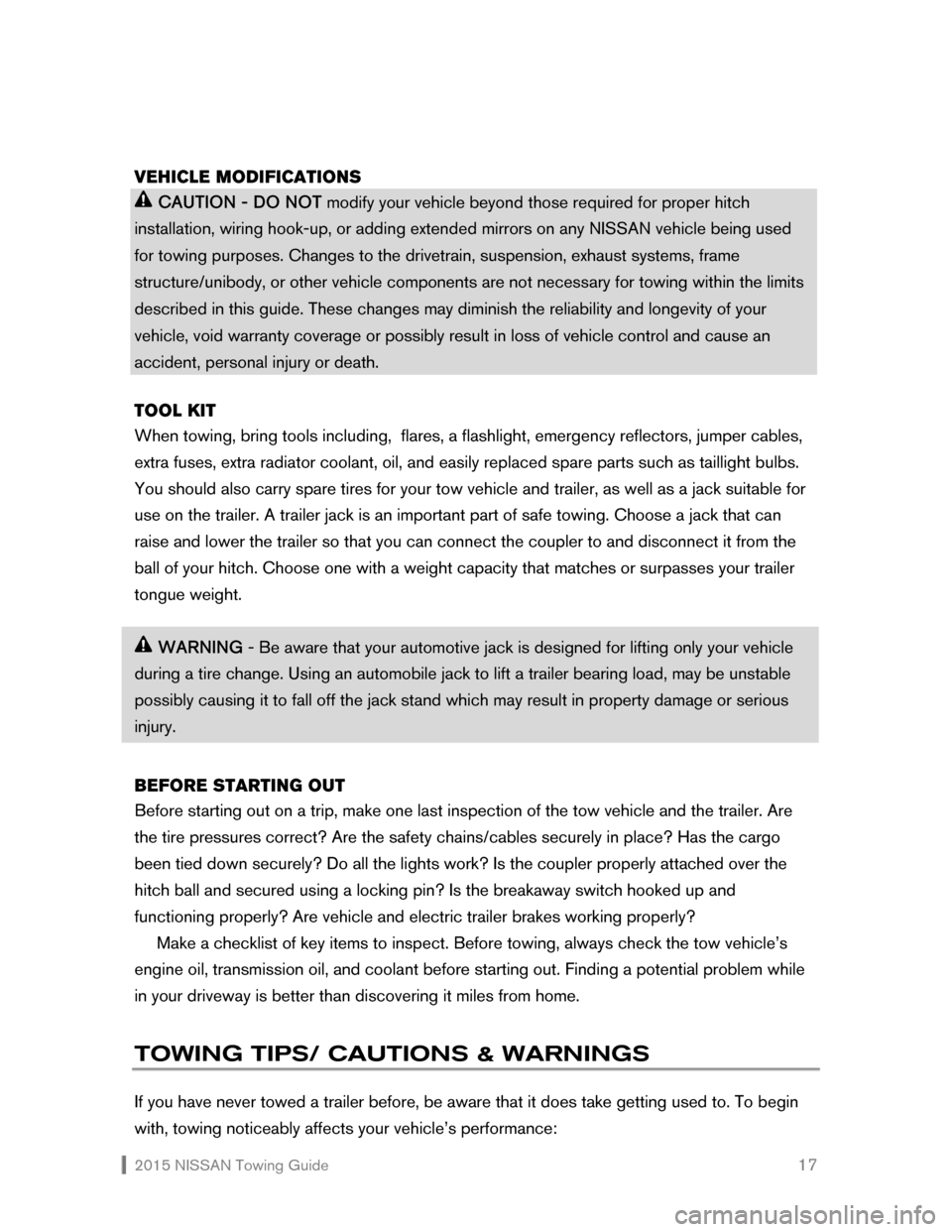
2015 NISSAN Towing Guide 17
VEHICLE MODIFICATIONS
CAUTION - DO NOT modify your vehicle beyond those required for proper hitch
installation, wiring hook-up, or adding extended mirrors on any NISSAN vehicle being used
for towing purposes. Changes to the drivetrain, suspension, exhaust systems, frame
structure/unibody, or other vehicle components are not necessary for towing within the limits
described in this guide. These changes may diminish the reliability and longevity of your
vehicle, void warranty coverage or possibly result in loss of vehicle control and cause an
accident, personal injury or death.
TOOL KIT
When towing, bring tools including, flares, a flashlight, emergency reflectors, jumper cables,
extra fuses, extra radiator coolant, oil, and easily replaced spare parts such as taillight bulbs.
You should also carry spare tires for your tow vehicle and trailer, as well as a jack suitable for
use on the trailer. A trailer jack is an important part of safe towing. Choose a jack that can
raise and lower the trailer so that you can connect the coupler to and disconnect it from the
ball of your hitch. Choose one with a weight capacity that matches or surpasses your trailer
tongue weight.
WARNING - Be aware that your automotive jack is designed for lifting only your vehicle
during a tire change. Using an automobile jack to lift a trailer bearing load, may be unstable
possibly causing it to fall off the jack stand which may result in property damage or serious
injury.
BEFORE STARTING OUT
Before starting out on a trip, make one last inspection of the tow vehicle and the trailer. Are
the tire pressures correct? Are the safety chains/cables securely in place? Has the cargo
been tied down securely? Do all the lights work? Is the coupler properly attached over the
hitch ball and secured using a locking pin? Is the breakaway switch hooked up and
functioning properly? Are vehicle and electric trailer brakes working properly?
Make a checklist of key items to inspect. Before towing, always check the tow vehicle’s
engine oil, transmission oil, and coolant before starting out. Finding a potential problem while
in your driveway is better than discovering it miles from home.
TOWING TIPS/ CAUTIONS & WARNINGS
If you have never towed a trailer before, be aware that it does take getting used to. To begin
with, towing noticeably affects your vehicle’s performance:
Page 22 of 27
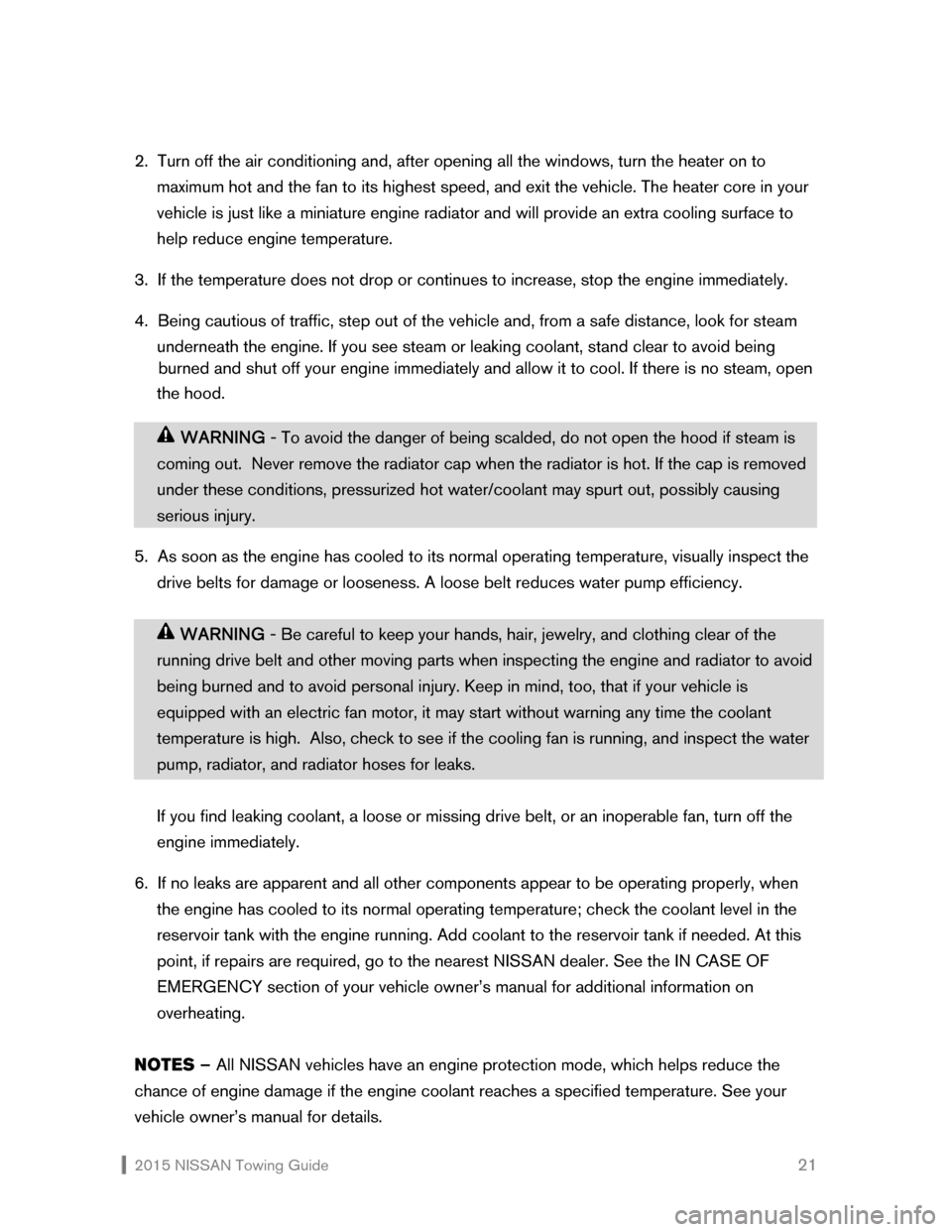
2015 NISSAN Towing Guide 21
2. Turn off the air conditioning and, after opening all the windows, turn the heater on to
maximum hot and the fan to its highest speed, and exit the vehicle. The heater core in your
vehicle is just like a miniature engine radiator and will provide an extra cooling surface to
help reduce engine temperature.
3. If the temperature does not drop or continues to increase, stop the engine immediately.
4. Being cautious of traffic, step out of the vehicle and, from a safe distance, look for steam
underneath the engine. If you see steam or leaking coolant, stand clear to avoid being
burned and shut off your engine immediately and allow it to cool. If there is no steam, open
the hood.
WARNING - To avoid the danger of being scalded, do not open the hood if steam is
coming out. Never remove the radiator cap when the radiator is hot. If the cap is removed
under these conditions, pressurized hot water/coolant may spurt out, possibly causing
serious injury.
5. As soon as the engine has cooled to its normal operating temperature, visually inspect the
drive belts for damage or looseness. A loose belt reduces water pump efficiency.
WARNING - Be careful to keep your hands, hair, jewelry, and clothing clear of the
running drive belt and other moving parts when inspecting the engine and radiator to avoid
being burned and to avoid personal injury. Keep in mind, too, that if your vehicle is
equipped with an electric fan motor, it may start without warning any time the coolant
temperature is high. Also, check to see if the cooling fan is running, and inspect the water
pump, radiator, and radiator hoses for leaks.
If you find leaking coolant, a loose or missing drive belt, or an inoperable fan, turn off the
engine immediately.
6. If no leaks are apparent and all other components appear to be operating properly, when
the engine has cooled to its normal operating temperature; check the coolant level in the
reservoir tank with the engine running. Add coolant to the reservoir tank if needed. At this
point, if repairs are required, go to the nearest NISSAN dealer. See the IN CASE OF
EMERGENCY section of your vehicle owner’s manual for additional information on
overheating.
NOTES – All NISSAN vehicles have an engine protection mode, which helps reduce the
chance of engine damage if the engine coolant reaches a specified temperature. See your
vehicle owner’s manual for details.